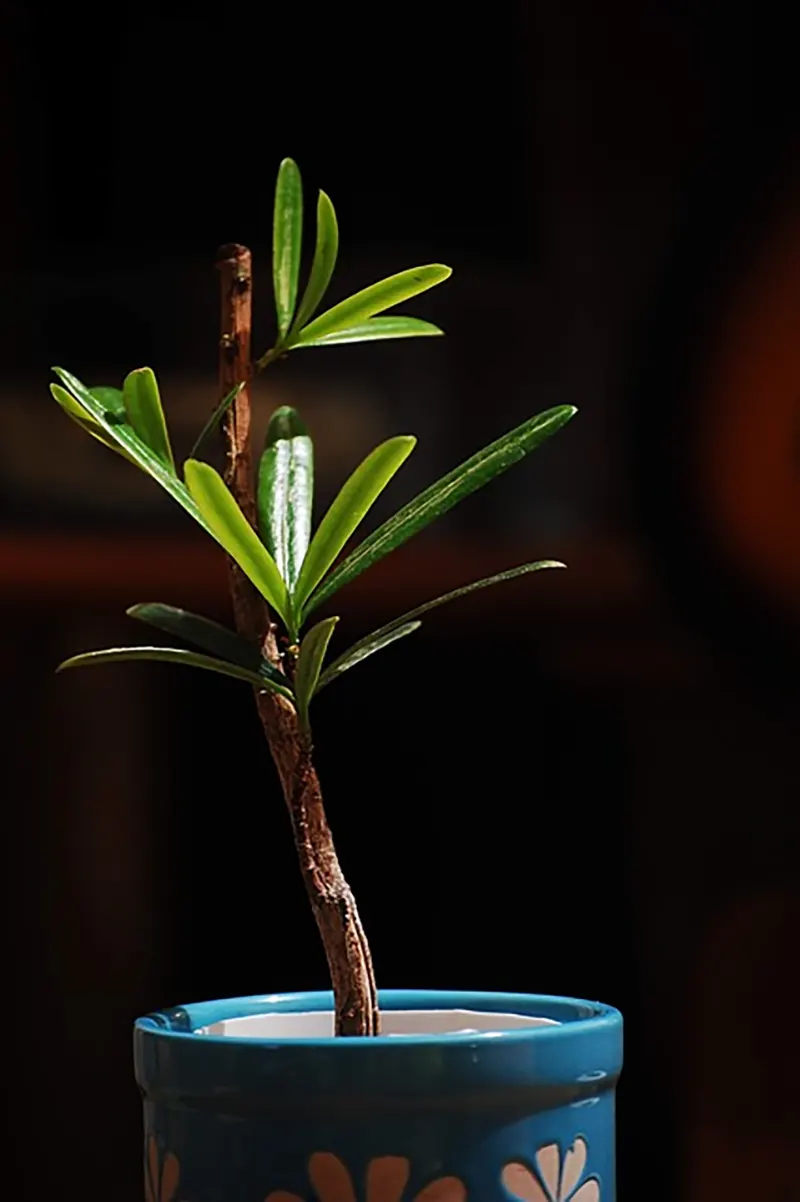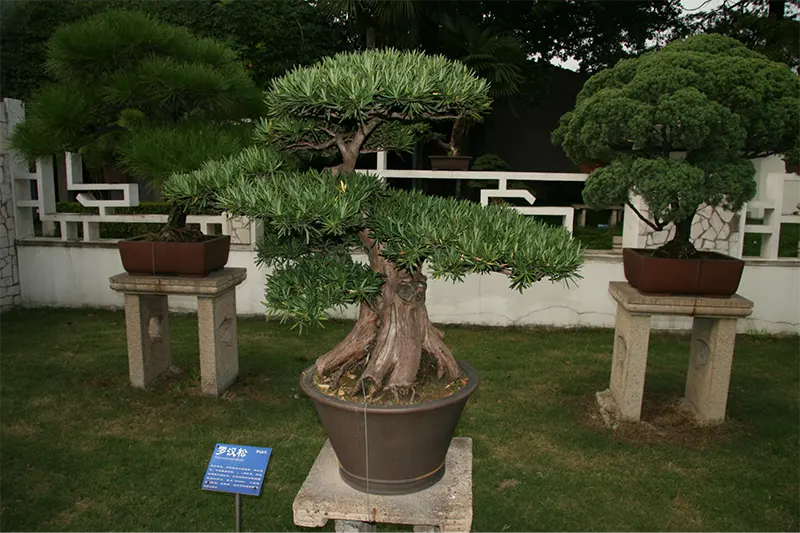How to Prune Podocarpus to Grow Thicker
Podocarpus has its own family within the Pine division as a gymnosperm. While the name may sound strange to beginners, you may have seen them grown as hedges along the borders of plots where a fence or wall would usually be. One question that many bonsai tree beginners ask is how to prune podocarpus to grow thicker.
There’s a good reason they ask this question. A podocarpus bonsai tree or hedge looks absolutely stunning when the foliage is fuller or thicker. If you just let them grow wildly, you’ll have long branches instead of a dense topping.
For that reason, we’re going to show you how to prune podocarpus to grow thicker and then care for it so it becomes stronger.
Table of Contents

How Fast Do Podocarpus Trees Grow?
Most coniferous trees grow tremendously slowly when compared to angiosperms. You’ll see about 1 to 3 feet of growth on your podocarpus tree every year. Even as a bonsai, this is incredibly slow. They start growing tall while younger, but they branch out as they mature. Keep reading our guide on how to prune podocarpus to grow thicker, and we’ll also show you how to make your podocarpus grow faster.
How to Grow Podocarpus Hedge or Bonsai Tree Thicker
In our article on how to thicken a podocarpus tree, we share various methods you can try. One of them is pruning your podocarpus in a way that it naturally develops thicker foliage. While we gave you a quick overview, we decided it best to provide a more detailed guide with steps.
Here’s how you prune podocarpus to grow thicker, whether it’s as a bonsai or hedge:
- Regularly trim your podocarpus before you do any hard pruning. Remember, pruning and trimming are two different actions. Wait for your branches to grow by six or seven nodes and trim back to four. This will encourage new growth.
- Only trim your podocarpus every few weeks or once a month. Doing so too soon after the previous trimming can cause damage to your tree in the long term.
- Perform hard pruning twice a year. You can do design pruning in summer when you see growth has slowed down and structural pruning in winter when your tree is dormant.
- You can also cut back your podocarpus after a few years. It may sound counter-productive, but you’ll get fuller foliage by removing some of the main branches for a better style.
- Make sure you water more than usual when trimming and pruning, as your podocarpus will be thirstier during these times. Keep an eye on the soil and make sure it doesn’t dry out.
If you continue to follow these steps every year, you’ll see a thicker podocarpus bonsai tree after a few years. It ensures that you see more fruit when the plant is at the right age, but you can also play with different bonsai styles by following this method.
Bonsai Tools Set with Wood Box 12PCS
Heavy Duty Bonsai Tree Kit, Trimming Scissor Shears, Concave Cutter, Wire Rolls, Wire Cutter and More, Gardening Bonsai Pruning & Care Kit

Learn About Podocarpus Plants
Now that you know how to prune podocarpus to grow thicker, you may want to learn more about the tree. Gaining knowledge of this family of plants will give you a more intimate relationship with your bonsai, and you’ll be inspired to care for it even more.
Here are a few considerations while trimming and pruning your podocarpus so it can become thicker.
How to keep the Podocarpus growing straight
As you may know, there are various bonsai styles in which you can develop your podocarpus while trimming and pruning. However, it won’t always be a breeze, and you may discover some branches heading in a way you never intended.
Here are some general rules for keeping your podocarpus growing straight while thickening it:
- Pruning: Regularly prune the branches to maintain a central leader or main trunk. Remove any side branches that are growing in a way that may cause the tree to lean or become unbalanced.
- Using the sun: Your podocarpus loves growing towards the sun, which you can use to your advantage. Every few days or once a week, turn the bonsai pot so that the other side faces the sun for a change. The leaves and branches will change direction, which will help straighten your tree.
- Staking: When the tree is young and flexible, you can stake it to provide support and encourage straight growth. Use a sturdy stake and loosely tie the trunk to it, allowing some movement for natural growth.
- Correcting leaning or crooked growth: If you notice the tree leaning or growing in a crooked manner, you can gently straighten it by tying it to a stake. Gradually adjust the tension over time until the tree grows straight.
- Wind protection: Strong winds can cause Podocarpus to lean or grow in a slanted manner. Planting the tree in a location that provides some natural wind protection, such as near a building or a windbreak, can help prevent this.
- Proper watering and fertilization: Ensure the tree is receiving adequate water and nutrients to promote healthy, upright growth. Follow the recommended watering and fertilization guidelines for Podocarpus.
Bonsai Potassium+ Feed
Liquid Fertilizer HighTech NPK+, Bonsai Food (Made in Germany)
Grow and Care for Podocarpus Trees
While making your podocarpus grow thicker, you’ll want to make sure you take proper care of it. From all your trimming and pruning, it will want more care and attention than before. Here are some guidelines on what to watch for as you thicken the foliage of your bonsai tree.
Light and Shade
There are two main points you need to know about lighting for podocarpus. Firstly, it needs about 6 hours of direct sunlight every day if you want the foliage to become thicker. Too little sunlight will make it grow long and thin, which is not what you want.
Secondly, having shade for the rest of the day will prevent the leaves from burning. It’s best to place it in a location that receives sunlight in the morning and evening while having shade for the peak afternoon. If you’ve placed your podocarpus bonsai outside, providing mesh shading above the plant will help.
Feeding with Fertilizer
Feeding your podocarpus only needs to happen around springtime when growth is at optimum levels. You can also feed it in summer, but we recommend doing so less frequently. You’ll want a balance of 6:6:6 to make sure it receives equal amounts of nitrogen, phosphorous, and potassium.
If you want to add excellent supplemental nutrients to make the podocarpus grow thicker, aim for iron and sulfur. You can either supply them in liquid or solid form, but we recommend the latter. Since your bonsai will grow slowly, having a slow-release fertilizer is best.
Soil and Watering
The podocarpus tree family is known for being drought-resistant. That means you can usually get away with watering once a week. However, your bonsai will become thirstier when you trim and prune, so you’ll want to increase watering during these times.
When it comes to the substrate, you should aim for loamy or sandy, alkaline, damp soil. This type of soil drains well and will ensure that your podocarpus bonsai remains healthy and strong. Also, you won’t need to fertilize for the first season when you buy proper new soil, as it should already have the nutrients the tree needs.
Pests and Diseases
Fortunately, the podocarpus tree is quite resilient to pests and diseases. That doesn’t mean there aren’t critters that won’t go for your thickened foliage. The two main culprits you’ll want to watch out for are aphids and scale insects. If you notice these feeding on the bark or leaves while doing your inspections, it’s time to buy an organic pesticide.
Keep in mind that podocarpus is used to dry, desert-like conditions. If you end up overwatering, you might introduce root rot to the soil. Make sure you let the soil dry out a bit before applying any more water to it.
Humidity and Temperature
While the podocarpus bonsai might enjoy dry, sunny conditions, it also loves humidity. You can either spray the leaves daily during the warmer seasons, or you can place a humidity tray under the pot. In this way, the hot sun will evaporate the water into the air, letting the leaves cool down.
When it comes to temperature, it depends on the podocarpus species. None of them like severe conditions, such as being too hot, cold, or windy. If your tree is outside, make sure it has some protection from the elements during the day. They are also not cold hardy, so bring your bonsai inside when it’s too cold.
Making your Podocarpus grow faster
The main ingredient for making your podocarpus grow faster is fertilizer. As long as you provide the 6:6:6 nitrogen, phosphorous, and potassium, along with the additional magnesium and sulfur, it will speed up the process. You can also feed it Epsom salts for extra magnesium if you wish.
Just remember one thing: the faster your podocarpus grows, the more you’ll need to trim and prune if you want the foliage to thicken. It’s essential to keep a watch on the growth rate and cut back on overlong branches.
Benefits of Growing a Podocarpus Bonsai Tree
We’ve shown you how to prune podocarpus to grow thicker and also how to care for it while doing so. You may now be wondering if it’s worth the effort to own one of these stunning bonsai trees.
Here are some advantages of growing a podocarpus bonsai tree:
- Podocarpus bonsai trees are relatively low maintenance compared to other bonsai tree species.
- They are known for their longevity and can live for many years with proper care.
- Podocarpus bonsai trees have dense and compact foliage, making them visually appealing.
- They can be easily trained and shaped into various bonsai styles, allowing for artistic expression.
- Podocarpus bonsai trees are adaptable to different growing conditions, including both indoor and outdoor environments.
- They have a high tolerance for pruning, allowing for regular shaping and maintenance.
- Podocarpus trees produce small, colorful fruits, adding an aesthetic element to the tree.
- They are known for their ability to purify the air, improving the overall indoor air quality.
- Podocarpus trees are resistant to pests and diseases, making them a hardy choice for bonsai enthusiasts.
They can be enjoyed as both a decorative element in a garden or as an indoor plant, providing versatility in placement options.
Final Thoughts on Pruning Podocarpus to Grow Thicker
Are you ready to prune podocarpus to grow thicker? We’ve tried to arm you with as many details as possible to get you excited and started with this new journey. As with any bonsai, it requires patience and care to get it where you want it to be, especially with gorgeous foliage containing tons of tiny fruit.
We would love to hear from you if you managed to develop a podocarpus bonsai tree with thick foliage and what worked for you. Feel free to let us know in the comments and share photos with us!











